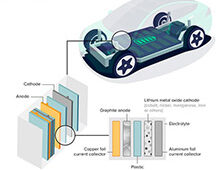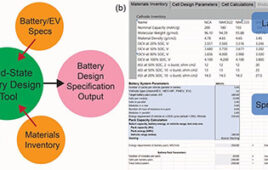The frequency at which droplets emerge is controlled by an acoustic trigger, which can be tuned so that each droplet containing a protein or virus meets an incoming pulse of x-rays. |
Flat is in the eye of the beholder.
When
you’re talking about nanomaterials, however, that eye is pretty much
useless unless it’s looking through an electron microscope or at a
computer visualization. Yet the pits and ridges on a seemingly flat
surface—so small they are invisible without such tools—can give the
material astonishing abilities. The trick for researchers interested in
taking advantage of these abilities lies in understanding and,
eventually, predicting how the microscopic topography of a surface can
translate into transformative technologies.
Drexel
University’s Yury Gogotsi and colleagues recently needed an atom’s-eye
view of a promising supercapacitor material to sort out experimental
results that were exciting but appeared illogical. That view was
provided by a research team led by Oak Ridge National Laboratory (ORNL)
computational chemists Bobby Sumpter and Jingsong Huang and
computational physicist Vincent Meunier.
Gogotsi’s
team discovered you can increase the energy stored in a carbon
supercapacitor dramatically by shrinking pores in the material to a
seemingly impossible size—seemingly impossible because the pores were
smaller than the solvent-covered electric charge-carriers that were
supposed to fit within them. The team published its findings in the
journal Science.
The
mystery was not simply academic. Capacitors are an important technology
that provides energy by holding an electrical charge. They have several
advantages over traditional batteries—charging and discharging nearly
instantaneously and recharging over and over again, almost indefinitely,
without wearing out—but they also have drawbacks—most importantly, they
hold far less energy.
An
electric double-layer capacitor, or supercapacitor, represents an
advance on the technology that allows for far greater energy density.
While in traditional capacitors two metallic plates are separated by a
nonconducting material known as a dielectric, in a supercapacitor an
electrolyte is able to form an electric double layer with electrode
materials that have very high surface areas.
As
such, supercapacitors are able to achieve the same effect within a
single material, as properties of the material divide it into separate
layers with a very thin, nonconducting boundary. Because they can both
forgo a bulky dielectric layer and make use of the carbon’s nanoscale
pores, supercapacitors are able to store far more energy than their
traditional counterparts in a given volume. This technology could help
increase the value of energy sources that are clean, but sporadic,
meting out stored energy during downtimes such as night for a solar cell
or calm days for a wind turbine.
So
Gogotsi’s discovery was potentially ground breaking. The energy was
stored in the form of ions within an electrolyte, with the ions
surrounded by shells of solvent molecules and packed on the surfaces of
nanoporous carbons. The researchers were able to control the size of
pores in the carbon material, making them 0.7 to 2.7 nanometers. What
they found was that the energy stored in the material shot up
dramatically as the pores became smaller than a nanometer, even though
the ions in their solvation shells could not fit into spaces that small.
“It
was a mystery,” Sumpter said. “Many people questioned the result at the
time. Yet the experimental data was showing an incredible increase in
capacitance.”
Fortunately, it was a mystery that the ORNL team could unravel.
“We
thought this was a perfect case for computational modeling because we
could certainly simulate nanometer-sized pores,” Sumpter said. “We had
electronic-structure capabilities that could treat it well, so it was a
very good problem for us to explore.”
Using
ORNL’s Jaguar and Eugene supercomputers, Sumpter and his team were able
to take a nanoscale look at the interaction between ion and carbon
surface. A computational technique known as density functional theory
allowed them to show that the phenomenon observed by Gogotsi was far
from impossible. In fact, they found that the ion fairly easily pops out
of its solvation shell and fits into the nanoscale pore.
“It
goes in such a way that it desolvates in the bulk to get inside because
there’s electrostatic potential and van der Waals forces that pull it
in,” Sumpter explained. “There are a whole lot of different forces
involved, but in fact it’s very easy for it to get in.”
The
ORNL team and colleagues at Clemson University, Drexel University, and
Georgia Tech detailed their findings in a series of publications,
including Angewandte Chemie, Chemistry-A European Journal, ACS Nano,
Journal of Chemical Physics C, Physical Chemistry Chemical Physics,
Journal of Materials Research, and Nano Letters.
“In
addition,” Sumpter noted, “the microscopic bumps and divots on a carbon
plate make a dramatic difference in the amount of energy that can be
stored on or in it.
“When
you get to the nanoscale, the surface area is huge, and the curvature,
both concave and convex, can be very large. This makes a large
difference in the capacitance. We derived a model that explained all the
experimental data. You can back out the pieces of the model from the
electronic structure calculations, and from that model you can predict
capacitance for different types of curved shapes and pore sizes.”
For
example, he said, the calculations showed that the charge-carrying ions
are stored not only by slipping into pores but also attaching to mounds
in the material.
“It’s
a positive curvature instead of a negative curvature,” Sumpter said,
“and they can store and release energy even faster. So you can store
ions inside a hole or you can store ions outside.”
Using
these and other insights gained through supercomputer simulation, the
ORNL team partnered with colleagues at Rice University to develop a
working supercapacitor that uses atom-thick sheets of carbon materials.
“It
uses graphene on a substrate and a polymer-gel electrolyte,” Sumpter
explained, “so that you produce a device that is fully transparent and
flexible. You can wrap it around your finger, but it’s still an energy
storage device. So we’ve gone all the way from modeling electrons to
making a functional device that you can hold in your hand.”
SOURCE: Oak Ridge National Laboratory





